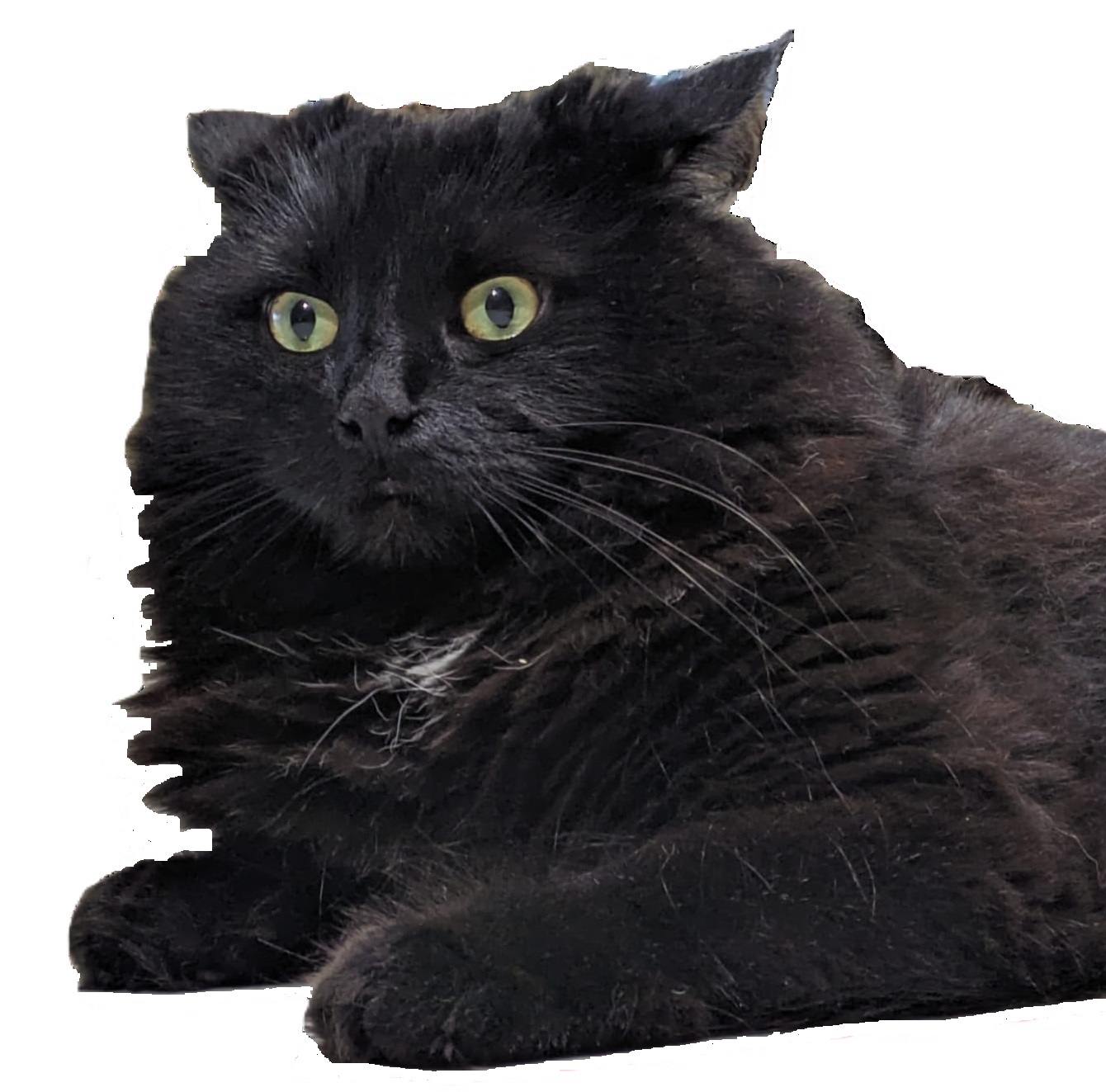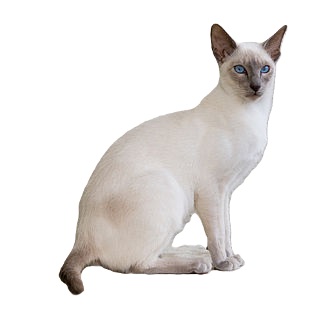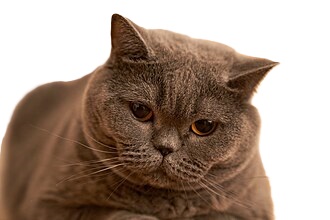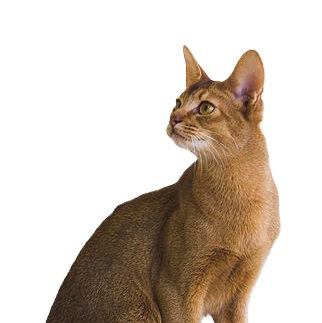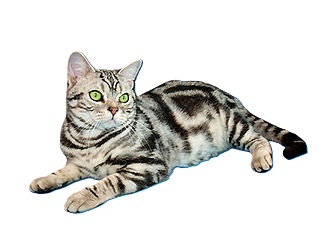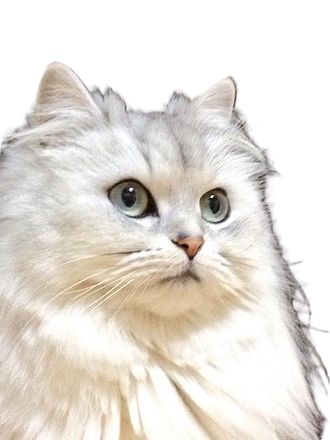Maine coon
Description
The Maine Coon is one of the largest and most popular cat breeds, known for its impressive size, friendly personality, and distinctive appearance.
Appearance
- Maine Coons are one of the largest domestic cat breeds. Males typically weigh between 13-18 pounds (5.9-8.2 kg), while females are usually slightly smaller at 8-12 pounds (3.6-5.4 kg). Some Maine Coons can weigh over 20 pounds, especially males, with lengths reaching up to 40 inches from nose to tail.
- They have a muscular, rectangular body with a broad chest and strong, sturdy legs. Their large paws, often with tufts of fur, are adapted for walking on snow, reflecting their origins in the cold climates of the northeastern United States.
- Maine Coons have a thick, water-resistant coat that is longer around the chest, stomach, and flanks, giving them a lion-like ruff. Their coat can come in a variety of colors and patterns, including solid, tabby, tortoiseshell, and more, with the brown tabby being one of the most recognized.
- Their long, bushy tail is another defining feature, often carried high, and serves to keep them warm by wrapping around their body in cold weather.
- They have large, tufted ears, often with lynx-like tips, which add to their wild and rugged appearance.
- Maine Coons have large, expressive, almond-shaped eyes that can be green, gold, copper, or blue (especially in white or partially white cats).
Personality
- Despite their size, Maine Coons are known for their gentle, friendly nature. They are often described as "gentle giants" due to their affectionate, calm demeanor.
- Maine Coons are loyal and enjoy the company of their human family, but they are not overly demanding of attention. They are happy to be nearby or follow you around the house but don’t typically exhibit clingy behavior.
- They are highly intelligent and enjoy interactive play, puzzles, and games. Many Maine Coons retain their playful, kitten-like behavior well into adulthood, and some even enjoy playing fetch or learning tricks.
- Maine Coons are often compared to dogs because of their playful, loyal, and trainable nature. They may follow their owners around, greet them at the door, or enjoy being part of family activities.
- While not as talkative as breeds like the Siamese, Maine Coons are known for their soft, chirping vocalizations rather than loud meowing. They will communicate with their owners in a distinctive, sweet-sounding way, especially when they want attention.
Health
- Maine Coons have a relatively long lifespan, typically living 12-15 years, though some can live even longer with proper care.
- While generally a healthy breed, Maine Coons are prone to some genetic health issues, including:
- Due to their large size, Maine Coons can be susceptible to hip dysplasia, a condition where the hip joint doesn't fit properly.
- Hypertrophic Cardiomyopathy (HCM) is genetic heart disease that can affect Maine Coons, causing the walls of the heart to thicken and leading to heart failure if not managed.
- Spinal Muscular Atrophy (SMA) affects the spinal cord’s motor neurons, leading to muscle weakness, although it doesn’t typically cause pain or shorten the cat's life.
- Polycystic Kidney Disease (PKD) is a genetic condition that affects some Persians, leading to the development of kidney cysts that can cause kidney failure over time.
- Polycystic Kidney Disease (PKD) is a genetic disorder that can lead to kidney dysfunction in some cats.
History
- The exact origins of the Maine Coon are not fully known, but they are believed to have developed naturally in the northeastern United States, specifically in Maine, where they became popular for their hunting skills and ability to survive harsh winters. One popular legend suggests they are the offspring of domestic cats and raccoons, although this is genetically impossible. Another theory is that they descended from long-haired cats brought to America by European sailors or even the cats belonging to Marie Antoinette, who allegedly sent her cats to America before her escape attempt.
- Maine Coons were popular in early American cat shows during the late 19th century, but their popularity waned when Persian cats became more fashionable. However, the breed made a comeback in the mid-20th century and is now one of the most popular cat breeds in the world.
Unique traits
- Many Maine Coons have a fascination with water. They may enjoy playing with water in their bowl or even join their owners in the bathroom, showing curiosity about running water.
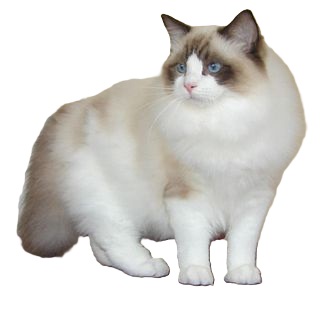
Ragdoll
Description
Ragdoll cats are a large, affectionate, and gentle breed known for their calm demeanor, striking blue eyes, and luxurious coat. They are famous for their tendency to go limp when picked up, much like a ragdoll, which is where their name comes from.
Appearance
- Ragdolls are one of the larger cat breeds, with males typically weighing between 15-20 pounds (6.8-9.1 kg) and females slightly smaller at 10-15 pounds (4.5-6.8 kg). They have a muscular yet soft and plush body.
- Ragdolls have a long, sturdy body with a broad chest, strong legs, and a proportionate tail. Their paws are rounded, and their legs are strong, making them well-balanced cats.
- Ragdolls have a semi-longhaired coat that is soft, silky, and plush. Their fur is not as prone to matting as other long-haired breeds, but regular grooming is still necessary. The coat comes in several patterns and colors:
- The most common patterns include:
- Darker coloration on the ears, face, paws, and tail, similar to Siamese.
- Similar to colorpoint but with white "mittens" on the paws and sometimes a white chin or belly stripe.
- White legs, inverted V-shaped white marking on the face, and white belly.
- Common colors include seal, blue, chocolate, lilac, and variations like flame and tortie.
- Ragdolls are known for their large, striking blue eyes, which can range from pale blue to deep sapphire.
Personality
- Ragdolls are incredibly affectionate and social cats, often described as "puppy-like" because of their love for following their owners around. They form strong bonds with their families and enjoy being close to their people.
- Known for their calm demeanor, Ragdolls are typically relaxed and easygoing. They are not as high-energy as some breeds, preferring to lounge around and enjoy the company of their humans.
- They are very gentle, even when handled by children or other pets. True to their name, Ragdolls tend to relax and go limp when held, which makes them great companions for people who enjoy cuddling with their pets.
- Ragdolls are generally quiet cats, though they will "talk" softly to their owners when they want attention or food. They are not known for being excessively vocal, unlike some other breeds.
- While Ragdolls do enjoy playtime, they are not particularly hyper or energetic. They prefer gentle, interactive games like chasing toys or playing fetch, but they are also content to nap and relax for long periods.
Health
- Ragdolls have a relatively long lifespan, typically living between 12-17 years, with some living even longer with proper care.
- While Ragdolls are generally healthy, they can be prone to a few genetic and breed-related health issues, such as:
- Hypertrophic Cardiomyopathy (HCM): This genetic heart condition, which causes the heart walls to thicken, is a concern in the breed. Reputable breeders test for this condition to minimize its occurrence.
- Some Ragdolls may be prone to developing bladder stones, so monitoring their diet and water intake is important.
- Due to their laid-back nature, Ragdolls can be prone to weight gain if not given a balanced diet and proper exercise.
History
- The Ragdoll breed was developed in the 1960s by Ann Baker, a breeder from California. The breed's foundation cat was a white long-haired cat named Josephine, who exhibited the breed’s distinctive calm temperament and affectionate nature. Through selective breeding, Baker produced the Ragdoll's characteristic traits, including its laid-back personality and plush coat.
- The breed quickly gained popularity due to its unique combination of size, beauty, and temperament. Today, Ragdolls are one of the most popular cat breeds in the United States and internationally.
Unique traits
- The tendency to go limp or "floppy" when picked up is one of the breed’s most famous traits. While not all Ragdolls exhibit this behavior, many are known to relax completely when held, making them excellent lap cats.
- Ragdolls often exhibit dog-like traits, such as following their owners around the house, greeting them at the door, and even learning to play fetch or other tricks.
Siberian
Description
The Siberian cat is a robust, athletic, and affectionate breed that originates from the forests of Russia. Known for their thick, luxurious coat and dog-like loyalty, Siberians are both stunning and personable, making them a favorite among cat enthusiasts.
Appearance
- Siberians are a large, muscular breed with males typically weighing between 15-20 pounds (6.8-9.1 kg) and females weighing slightly less at 10-15 pounds (4.5-6.8 kg). Their strong build gives them a substantial, powerful appearance.
- They have a compact, well-muscled body with strong legs and large, tufted paws designed to help them traverse snow. Their hind legs are slightly longer than their front legs, which gives them excellent agility and jumping ability.
- Siberians have a dense, triple-layered coat designed to withstand cold climates. Their fur is semi-long to long, with a thick ruff around the neck and longer fur on the tail, britches (back of the legs), and chest. The coat is water-resistant, helping them endure harsh weather conditions.
- Siberians come in a wide variety of colors and patterns, including solid, tabby, tortoiseshell, bicolor, and colorpoint (similar to Siamese). Common colors include brown, blue, black, red, and cream.
- Their tail is thick, bushy, and long, often as long as their body. It helps keep them warm by wrapping it around their body in cold weather.
- Siberians have large, rounded eyes that come in shades of green, gold, or copper. In colorpoint Siberians, the eyes are typically blue.
Personality
- Siberian cats are known for their strong bond with their owners. They are affectionate and enjoy being close to their family members, often following them around the house or sitting beside them. Their loyalty and tendency to be near their humans have earned them a reputation for being "dog-like."
- Siberians are active cats with a high level of energy. They enjoy playtime and are excellent jumpers and climbers, making them well-suited to homes with cat trees or perches. Despite their energy, they are not typically hyperactive and balance playtime with relaxation.
- Siberians are highly intelligent cats and enjoy interactive toys, puzzle feeders, and games that challenge their minds. They are curious by nature and love to explore their environment, often finding their way into cabinets or high places.
- Siberians are known for their adaptability and can adjust to new environments, people, and pets more easily than many other breeds. They tend to be calm and handle changes in their surroundings well.
- Siberians communicate through soft chirps, trills, and purring rather than loud meowing. They will "talk" to their owners, but they are not as vocal as breeds like the Siamese.
Health
- Siberians have a relatively long lifespan, typically living between 12-15 years, with some living even longer.
- While generally a healthy breed, Siberians can be prone to a few health issues, including:
- Hypertrophic Cardiomyopathy (HCM): This genetic heart condition, which causes the heart walls to thicken, is a concern in the breed. Reputable breeders test for this condition to minimize its occurrence.
- Due to their love of food, Siberians can gain weight if not properly exercised and fed a balanced diet.
- While not a health issue specific to the cat, Siberians are often marketed as being hypoallergenic. They produce less of the protein Fel d 1, which is the main allergen in cat saliva, making them a better choice for some allergy sufferers. However, no cat is truly hypoallergenic, and allergic reactions can still occur.
History
- Siberians are an ancient breed that developed naturally in the cold, forested regions of Russia. They have existed for centuries, thriving in harsh climates due to their thick coats and strong survival instincts. They were valued for their hunting skills and were often kept as working cats in Russian villages to control rodent populations.
- Although Siberians were well-known in Russia, they were not introduced to the West until the 1990s. The breed gained recognition and popularity quickly due to their striking appearance and affectionate nature. They are now recognized by major cat associations, including The International Cat Association (TICA) and the Cat Fanciers' Association (CFA).
Unique traits
- Many Siberians have a fascination with water, and it’s not uncommon to see them playing in water bowls or watching running faucets with curiosity. This is a trait they share with other water-loving breeds like the Maine Coon and Turkish Van.
- Siberians are often marketed as hypoallergenic due to their lower levels of the Fel d 1 protein, which causes allergies in humans. While they are not completely allergen-free, they may be better tolerated by some allergy sufferers compared to other breeds.
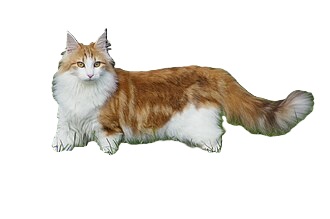
Norwegian Forest
Description
The Norwegian Forest Cat, often referred to as the “Wegie,” is a large, hardy, and ancient breed that hails from the cold forests of Norway. Known for its strong, muscular build and luxurious, water-resistant coat, this breed is both visually striking and affectionate.
Appearance
- Norwegian Forest Cats are large, muscular cats with males typically weighing between 12-16 pounds (5.4-7.3 kg), and females slightly smaller at 9-12 pounds (4-5.4 kg). They have a robust build, giving them a powerful, sturdy appearance.
- They have a long, strong body with a deep chest and long, sturdy legs. Their large, tufted paws are adapted for walking on snow, and their hind legs are slightly longer than their front legs, giving them excellent climbing abilities.
- One of the Norwegian Forest Cat’s most distinctive features is its thick, double-layered coat. The outer layer is long and water-resistant, while the undercoat is dense and woolly, providing insulation during cold weather.
- Their coat comes in a wide variety of colors and patterns, including solid, tabby, tortoiseshell, bicolor, and more. The coat's length and density vary with the seasons, becoming thicker in winter.
- Their long, bushy tail is another defining feature, which they use to wrap around themselves to stay warm in cold weather. The tail is often as long as the body.
- Their large, wide-set ears often have lynx-like tufts at the tips and are well-furred inside, protecting them from the cold.
- They have large, almond-shaped eyes that can be green, gold, or copper, with white cats sometimes having blue or odd-colored eyes.
Personality
- Norwegian Forest Cats are affectionate with their families but are not as demanding of attention as some other breeds. They enjoy being around their people but are also independent and can be content on their own.
- Despite their wild appearance, Norwegian Forest Cats are known for their gentle, calm demeanor. They are generally relaxed and easygoing, making them a good fit for various households.
- Norwegian Forest Cats are natural hunters and climbers, and they retain their playful instincts well into adulthood. They enjoy interactive play and need spaces to climb and explore, making cat trees and perches ideal for them.
- They are intelligent cats that enjoy solving problems and figuring out how to get into things. Their curious nature means they are often exploring new areas of the house and can learn how to open doors or cabinets.
- Norwegian Forest Cats are generally adaptable and handle changes in their environment well. They can adjust to new people, pets, or surroundings with minimal stress.
History
- The Norwegian Forest Cat is an ancient breed that developed naturally in the forests of Norway, where it evolved to survive the harsh, cold climate. They are believed to have been companions of Vikings and feature in Norse mythology as the "Skogkatt," a mystical, giant cat that could climb sheer rock faces.
- Although they’ve existed for centuries, the Norwegian Forest Cat was nearly wiped out during World War II. A breeding program was established in the 1970s to preserve the breed, and it was officially recognized by the Fédération Internationale Féline (FIFe) in 1977. The breed gained popularity internationally and is now recognized by major cat registries like The International Cat Association (TICA) and the Cat Fanciers' Association (CFA).
Unique traits
- Norwegian Forest Cats are natural climbers, a trait inherited from their ancestors who lived in the forests of Norway. They love high places and will often seek out elevated spots in the home to survey their surroundings.
- Their dense, water-resistant coat allows them to tolerate wet and cold conditions, a remnant of their forest-dwelling ancestors.
- Norwegian Forest Cats are featured in Norse mythology. The goddess Freya is said to have traveled in a chariot pulled by giant cats resembling the Norwegian Forest Cat.
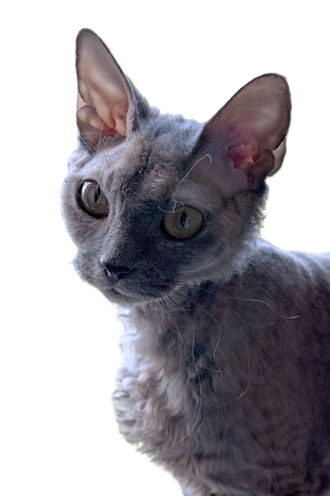
Devon Rex
Description
The Devon Rex is a distinctive and charming breed known for its large ears, curly coat, and playful personality. Often described as “pixie-like” due to their mischievous nature and unique appearance, Devon Rex cats make for lively, affectionate, and entertaining companions.
Appearance
- Devon Rex cats are small to medium in size, with adults typically weighing between 6-9 pounds (2.7-4.1 kg). They have a slender yet muscular build, giving them an athletic and agile appearance.
- The Devon Rex has a compact, fine-boned body with long legs and a broad chest. Their slim figure contrasts with their relatively large head, making them appear somewhat “alien” or elf-like.
- One of their most striking features is their oversized, bat-like ears, which are set low on the sides of the head. Their large ears give them a unique, whimsical look.
- Their coat comes in a wide range of colors and patterns, including solid, tabby, tortoiseshell, bicolor, and colorpoint (similar to the Siamese). Coat thickness can vary depending on the individual cat, and some may have bald patches.
- They have large, oval-shaped eyes that are often bright and expressive. Their eye color usually complements their coat, with shades of green, gold, blue, or copper.
- The tail is long, slender, and covered in a light layer of fur that is often curly or wavy like the rest of the coat.
Personality
- Devon Rex cats are known for their playful, energetic, and mischievous nature. They enjoy interactive play and can often be found jumping, climbing, or exploring. They have a strong desire to be involved in everything their human is doing, making them highly engaging companions.
- These cats are very people-oriented and love being around their human family. They are known for their affectionate nature and will often curl up on your lap or cuddle next to you in bed. They enjoy being the center of attention and are not shy about seeking affection.
- Devon Rex cats are highly intelligent and quick learners. They enjoy puzzle toys and interactive games that challenge their minds. Their curiosity often leads them to explore cabinets, open doors, or figure out how to get into places they shouldn’t.
- Devon Rex cats are sometimes compared to dogs because of their strong attachment to their owners and their willingness to follow their humans around the house. They may even learn to play fetch or perform tricks like a dog.
- Devon Rex cats are known to be chatty, but their voice is usually soft and sweet. They enjoy “talking” to their owners, especially when they want attention, but they are not as loud or demanding as some breeds.
History
- The Devon Rex was first discovered in Devon, England, in 1960. The breed’s origins trace back to a stray cat named Kirlee, who had a naturally curly coat. Kirlee’s unique fur led to further breeding efforts, and the Devon Rex was officially recognized as a distinct breed from the Cornish Rex, another curly-coated breed from a neighboring region.
- Through careful breeding, the Devon Rex developed its distinctive appearance and playful personality. The breed was recognized by The International Cat Association (TICA) in 1979 and the Cat Fanciers' Association (CFA) in 1983, and has since gained popularity worldwide.
Unique traits
- The Devon Rex’s curly or wavy coat is one of the breed’s most distinctive features. It’s caused by a genetic mutation that affects the structure of the hair shaft.
- Their oversized ears and large, expressive eyes give them a pixie-like or “elfin” appearance, making them stand out among other cat breeds.
- Devon Rex cats are known for their love of warmth. Due to their thin coat, they often seek out warm spots in the house, such as laps, blankets, or even electronic devices.
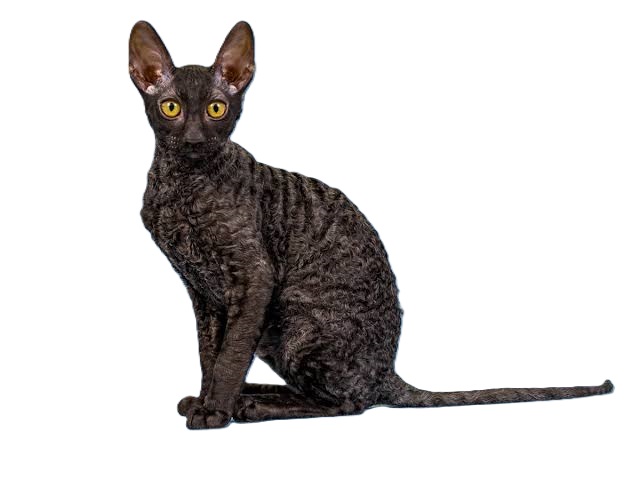
Cornish Rex
Description
The Cornish Rex is a unique and playful cat breed known for its distinctively soft, wavy coat and slender, elegant appearance. Despite its delicate look, the Cornish Rex is an energetic and athletic cat with a fun-loving and affectionate personality.
Appearance
- Cornish Rex cats are medium-sized, typically weighing between 6-10 pounds (2.7-4.5 kg). They have a slender, lithe, and graceful build with a lean but muscular body.
- Their body is long and slender, with an arched back, long legs, and a narrow, whip-like tail. They have fine bone structure and are light on their feet, giving them a very agile and athletic appearance.
- One of the most distinctive features of the Cornish Rex is its soft, wavy coat. Unlike most cats, which have three layers of fur (guard, awn, and down hairs), the Cornish Rex only has down hairs, the softest layer. This gives their coat its signature velvety texture.
- The breed comes in a variety of colors and patterns, including solid, tabby, bicolor, and tortoiseshell. The coat can be any color, from black to white to blue, and even more exotic patterns like smoke or shaded.
- The Cornish Rex has a small, egg-shaped head with prominent cheekbones, a strong chin, and large, wide-set ears that sit high on the head. They have oval-shaped eyes that can come in a variety of colors depending on their coat color.
- Their long, slender tail is often described as whip-like and is covered with the same fine, wavy fur that covers the rest of their body.
Personality
- Cornish Rex cats are known for their high energy levels and playful nature. They are active, agile, and enjoy running, jumping, and playing well into adulthood. They often exhibit kitten-like behavior even as they grow older.
- Cornish Rex cats are very affectionate and thrive on human attention. They enjoy being with their people and will often follow their owners around the house. They are known to seek out attention and will climb into laps, snuggle under blankets, and nudge their owners for affection.
- These cats are intelligent and curious, often investigating every corner of the house. They enjoy puzzle toys and interactive play that challenges their minds.
- While not overly loud, the Cornish Rex can be quite vocal, using soft meows and chirps to communicate with their owners. They often “talk” when they want attention or when they are excited about something.
- Cornish Rex cats are often compared to dogs because of their social and playful nature. They can be trained to fetch, come when called, and even perform tricks. They also enjoy playing games like fetch and will often bring toys to their owners to continue playtime.
History
- The Cornish Rex originated in Cornwall, England, in the 1950s. The first Cornish Rex, a kitten named Kallibunker, was born in 1950 on a farm in Cornwall. He had an unusual wavy coat, the result of a natural genetic mutation. His owner, intrigued by this unique coat, began a breeding program to develop the breed.
- The breed was established through selective breeding with other cats, including domestic shorthairs and Burmese. The gene responsible for the Cornish Rex’s wavy coat is recessive, so careful breeding was necessary to preserve the trait. The breed quickly gained popularity and was recognized by major cat associations, including The International Cat Association (TICA) and the Cat Fanciers' Association (CFA).
Unique traits
- The most recognizable feature of the Cornish Rex is its soft, wavy coat. This is due to a genetic mutation that affects the hair’s structure, resulting in the unique curl that sets the breed apart.
- Cornish Rex cats are often described as having “boundless energy.” They love to play and are known for their acrobatic abilities, often jumping to high places and running at full speed around the house.
- Due to their thin coat, Cornish Rex cats love warmth and will often seek out sunny spots, blankets, or even cuddle with their owners to stay warm. They can frequently be found snuggling under blankets or curling up in the warmest spots in the house.
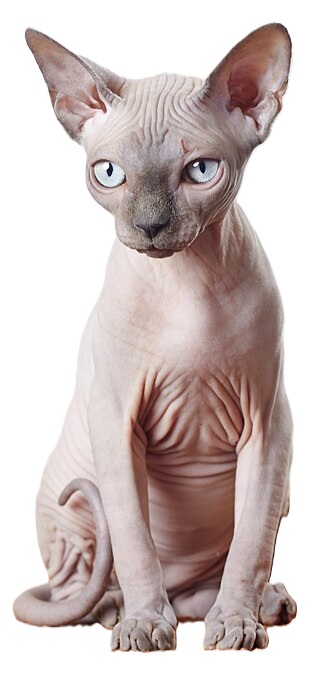
Sphynx
Description
The Sphynx is a unique and striking cat breed known for its lack of fur, wrinkled skin, and affectionate personality. Despite their "alien" appearance, Sphynx cats are warm, playful, and highly social, making them beloved by many cat enthusiasts.
Appearance
- Sphynx cats are medium-sized with a muscular and sturdy body. They typically weigh between 6-12 pounds (2.7-5.4 kg), with males often being larger than females.
- The Sphynx has a well-rounded body with a broad chest, muscular limbs, and a whip-like, tapering tail. Their body is often described as having a "potbelly," adding to their distinctive look.
- The most notable feature of the Sphynx is its lack of fur. Their skin is covered in a fine, downy fuzz that gives them a suede-like or peach-fuzz texture. While they appear hairless, they are not completely bald, and some individuals may have sparse hair on their ears, nose, tail, or paws.
- Sphynx cats have prominent wrinkles, particularly around the head, shoulders, and neck. These wrinkles are a natural feature of the breed and contribute to their distinctive appearance.
- Though they lack fur, Sphynx cats come in a variety of colors and patterns. Their skin can be any color or pattern, including solid, tabby, tortoiseshell, bicolor, and more.
- Sphynx cats have large, bat-like ears that stand upright. Their ears are wide at the base and taper to a rounded tip, giving them a striking and alert expression.
- They have large, lemon-shaped eyes that are wide-set and expressive. The color of their eyes can vary widely, and it often contrasts beautifully with their skin.
Personality
- Sphynx cats are known for their extremely affectionate and people-oriented nature. They love being close to their humans and often follow them around the house, eager for attention and interaction. They are often described as "dog-like" in their loyalty and need for companionship.
- Despite their sophisticated appearance, Sphynx cats are highly playful and active. They enjoy interactive toys, climbing, and chasing games. They are known for being mischievous and curious, often exploring every nook and cranny of their environment.
- Sphynx cats are typically outgoing and sociable, both with their families and strangers. They enjoy being the center of attention and are not shy about demanding affection. Their bold personality makes them great pets for households with lots of activity and visitors.
- Sphynx cats are known to be vocal and will communicate with their owners through various meows, chirps, and purrs. They enjoy "talking" and will often express their needs, whether it's for food, attention, or play.
History
- The Sphynx breed originated in the 1960s when a domestic cat in Canada gave birth to a hairless kitten due to a natural genetic mutation. This hairless trait was selectively bred over time to create the Sphynx breed as we know it today. The breed was further developed through outcrossing with other cat breeds, such as the Devon Rex, to create a more robust gene pool and ensure genetic diversity.
- The breed was officially recognized by The International Cat Association (TICA) in the 1980s and later by the Cat Fanciers' Association (CFA). Despite their relatively recent development, the Sphynx has gained immense popularity worldwide due to its unique appearance and friendly nature.
Unique traits
- Due to their lack of fur, Sphynx cats are naturally drawn to warm spots. They love cuddling up with their owners or basking in the sun (with precautions) to stay warm.
- While Sphynx cats are often considered hypoallergenic due to their lack of fur, they still produce the allergenic protein Fel d 1 in their saliva and skin oils, which can trigger allergies in sensitive individuals. However, some people with mild cat allergies may find they have fewer symptoms around Sphynx cats.
- Sphynx cats dislike being alone and need companionship. They do well in homes where someone is around most of the time or where they have other pets to keep them company.
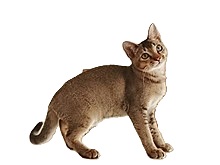
Singapura
Description
The Singapura is one of the smallest and most unique cat breeds, known for its petite size, big eyes, and playful, affectionate personality. Originating from Singapore, they are often referred to as “Singapore’s street cats” and have gained popularity for their charming appearance and lively nature.
Appearance
- Singapuras are one of the smallest cat breeds in the world. Males typically weigh between 6-8 pounds (2.7-3.6 kg), while females are smaller, averaging around 4-6 pounds (1.8-2.7 kg). Despite their small size, they have a muscular, compact build.
- They have a compact, athletic body with a slightly rounded chest and muscular limbs. Their small but strong frame allows them to be agile and active.
- Singapuras have a short, fine coat that lies close to the body, giving them a sleek appearance. The coat is smooth and silky to the touch, requiring minimal grooming.
- The Singapura comes in one recognized color—sepia agouti. This gives the breed a unique ticked coat, with each hair banded in two colors (dark brown and light ivory). This creates a warm, ivory appearance with a delicate ticking of brown, giving them a distinctive look.
- Their tails are slender, medium-length, and taper slightly toward the tip.
- One of the most striking features of the Singapura is its large, expressive eyes, which are almond-shaped and can be hazel, green, or yellow. The eyes are often emphasized by a dark outline that enhances their size and gives them a captivating look.
- They have large, wide-set ears that are slightly pointed, adding to their alert and curious appearance.
Personality
- Singapuras are affectionate and love being around people. They are very social cats and often seek out attention from their owners. They enjoy sitting on laps, cuddling, and being close to their family members.
- Despite their small size, Singapuras are highly energetic and playful. They retain a kitten-like energy well into adulthood and love interactive play. They enjoy climbing, jumping, and exploring, making them quite active and agile.
- Singapuras are naturally curious cats and love to investigate their surroundings. They are intelligent and enjoy mental stimulation, such as puzzle toys and interactive games. Their inquisitive nature makes them prone to exploring every corner of the house.
- Singapuras thrive on companionship and are known for being “velcro cats,” often sticking close to their human family members. They enjoy being involved in daily activities and are happiest when they are part of the household’s action.
- While Singapuras are not as vocal as some other breeds (like the Siamese), they do communicate with soft, gentle chirps and meows. They will “talk” to their owners when they want attention or food but generally are not overly noisy.
History
- The Singapura’s origins can be traced back to the streets of Singapore, where they were known as "drain cats" because they were often found near storm drains. In the 1970s, the breed was introduced to the United States by expatriates Hal and Tommy Meadows, who brought a few of these small cats back with them. The breed was further developed and gained recognition for its unique appearance and charming personality.
- The Singapura gained official recognition by The International Cat Association (TICA) in the late 1970s and the Cat Fanciers' Association (CFA) in 1988. It has since become a beloved breed worldwide, though it remains relatively rare.
Unique traits
- One of the most defining traits of the Singapura is its petite size, making it one of the smallest cat breeds in the world. Despite their small stature, they are strong, muscular, and agile.
- Their disproportionately large eyes and ears, compared to their small body, give them a distinctive and endearing look, often described as kitten-like even in adulthood.
- Singapuras love being around people and are often called "velcro cats" because they stick close to their owners, following them around and always wanting to be involved in whatever their humans are doing.
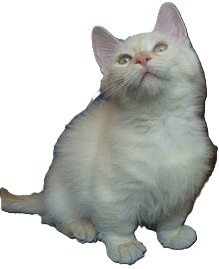
Munchkin
Description
The Munchkin cat is a unique and distinctive breed known for its unusually short legs, a result of a genetic mutation. Despite their short stature, Munchkins are energetic, playful, and affectionate, making them a popular choice for cat lovers who appreciate their cute and compact appearance.
Appearance
- Munchkins are medium-sized cats, typically weighing between 5-9 pounds (2.3-4.1 kg). They have a well-proportioned body, with their short legs being the most striking feature.
- The Munchkin’s defining characteristic is its short legs, which result from a genetic mutation that causes the long bones in the legs to be shorter than usual. These short legs do not impair the cat’s mobility, and Munchkins can run, jump, and play just like other cats, though they may not jump as high.
- Munchkins have a compact, sturdy body with a slightly arched back, which gives them a somewhat elongated appearance despite their short legs. Their legs can vary in length, with some being very short and others slightly longer.
- Munchkins can have either short or long coats, depending on the individual cat. Both types of coats are soft, plush, and easy to maintain.
- Short-haired Munchkins: Their coat is dense and silky, requiring minimal grooming.
- Long-haired Munchkins: Their coat is slightly longer and may have a more flowing, silky texture, requiring a bit more grooming to prevent tangles.
- Colors: Munchkins come in a wide range of colors and patterns, including solids, tabbies, tortoiseshell, bicolor, and more.
- Munchkins have a medium to long tail that is thick and often bushy, especially in long-haired varieties.
- They have large, expressive, almond-shaped eyes that come in a variety of colors, depending on their coat color.
Personality
- Despite their short legs, Munchkins are very playful and active cats. They are curious by nature and enjoy running, chasing toys, and playing games with their owners. Their short legs do not slow them down, and they are surprisingly fast and agile.
- Munchkins are known for their affectionate and friendly personalities. They enjoy spending time with their human companions and tend to be social, making them a good fit for families or households with other pets.
- Munchkins are intelligent cats that enjoy exploring their environment. They are known to open cabinets, investigate new objects, and engage in interactive play that stimulates their minds.
- Munchkins are generally confident and outgoing cats. They are not shy and tend to adjust well to new environments, people, and pets.
- In addition to their playful nature, Munchkins can also be quite loving and enjoy cuddling with their owners. They are known to be lap cats and love being close to their human family.
History
- The Munchkin breed is relatively new, first gaining recognition in the early 1990s. However, cats with short legs have appeared throughout history. The modern Munchkin breed traces its roots to a stray short-legged cat named Blackberry, found in Louisiana in the 1980s. She became the foundation of the breed after her kittens also exhibited the short-legged trait.
- The Munchkin cat’s unique appearance is due to a natural genetic mutation that affects bone growth. This mutation is dominant, meaning only one parent needs to carry the gene for a kitten to have short legs. Breeders began selectively breeding for this trait, and in 1994, The International Cat Association (TICA) officially recognized the breed. While still controversial in some circles due to concerns about the ethics of breeding for a physical mutation, Munchkins have gained a devoted following.
Unique traits
- Munchkins are known for their playful, ferret-like movements, especially when they run or chase toys. Their short legs give them a distinctive gait, which adds to their charm and playful nature.
- Munchkins are often seen sitting up on their hind legs, similar to a meerkat or rabbit, especially when they are curious about something. This behavior is both endearing and characteristic of the breed.
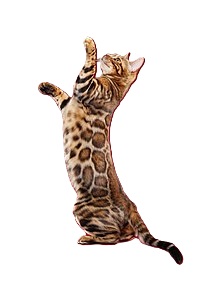
Bengal
Description
The Bengal cat is an exotic, energetic, and highly intelligent breed known for its striking wild appearance and playful, adventurous personality. Originally developed to resemble wild leopards and ocelots, Bengals are prized for their beautifully patterned coats and active nature.
Appearance
- Bengals are medium to large cats, with males typically weighing between 10-15 pounds (4.5-6.8 kg) and females slightly smaller at 8-12 pounds (3.6-5.4 kg). They are muscular and athletic, with a sleek, streamlined build.
- Bengals have a long, muscular body with a strong, athletic frame. They are very agile and well-coordinated, which makes them excellent jumpers and climbers.
- Bengals are most famous for their distinctive, short coat, which is soft, sleek, and comes in a variety of colors and patterns. The coat often has a glittery or iridescent sheen.
- The most common coat patterns are:
- Spotted/Leopard Pattern: Resembling the spots of a leopard, the coat is covered in random, rosette-shaped spots that give Bengals their wild look.
- Marbled Pattern: Instead of spots, the coat has large, swirling patterns that resemble marble or liquid flowing.
- Common colors include brown, silver, snow (a pale cream with blue eyes), and charcoal, but there are many variations.
- Bengal cats have large, almond-shaped eyes that are typically gold, green, or blue, depending on the coat color.
- Their tail is thick, with a rounded tip, and is often marked with black rings or spots.
Personality
- Bengals are known for their high energy levels and love of play. They are constantly on the move, exploring, jumping, and climbing. They require a lot of mental and physical stimulation to stay happy.
- Bengals are extremely curious cats and love to explore every nook and cranny of their environment. They enjoy being involved in whatever their owners are doing and often follow them around the house.
- Bengals are among the most intelligent cat breeds. They can learn tricks, solve puzzles, and even figure out how to open doors or cabinets. Their intelligence requires interactive toys and activities to keep them engaged.
- Bengals are affectionate with their owners and enjoy being part of the family, but they are not typically lap cats. They prefer to interact through play or by following their humans around. Despite their independent streak, they form strong bonds with their families and crave attention and companionship..
- Bengals are known to be vocal and will "talk" to their owners through a range of meows, chirps, and yowls. They often use these sounds to express their needs or communicate their curiosity.
History
- The Bengal cat is a relatively new breed, developed in the 1960s by Jean Mill, a breeder in the United States who crossed an Asian leopard cat (a small wild feline) with a domestic cat. The goal was to create a domestic breed that had the look of a wild cat but with a tame and affectionate personality. Through careful breeding, the Bengal developed into the breed it is today, maintaining the wild appearance while being completely domestic.
- By the 1980s, Bengals were gaining popularity, and they were eventually recognized by The International Cat Association (TICA) and other cat registries. Today, Bengals are one of the most popular cat breeds due to their exotic appearance and playful personality.
Unique traits
- Bengals are one of the few cat breeds that resemble their wild ancestors so closely. Their coat patterns, sleek build, and expressive eyes give them the look of a wild jungle cat, despite being completely domestic.
- Many Bengals are fascinated by water and may enjoy playing in it or even joining their owners in the shower. They might dip their paws in water bowls or explore running faucets.
- Bengals love to climb and will often seek out the highest point in a room to survey their surroundings. Cat trees, shelves, and other elevated spaces are perfect for them to indulge this behavior.
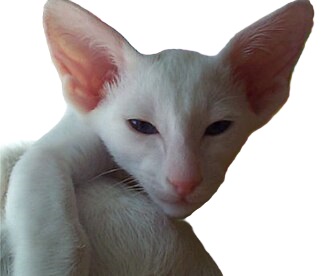
Oriental shorthair
Description
The Oriental Shorthair is a sleek, elegant, and highly intelligent breed known for its close connection to the Siamese. These cats are loved for their striking appearance, large variety of colors and patterns, and affectionate, social nature.
Appearance
- Oriental Shorthairs are medium-sized cats with a slender, graceful build. They typically weigh between 6-12 pounds (2.7-5.4 kg). Their long, lean body gives them a refined, athletic look.
- Their body is long and tubular, with fine bones and muscles. They have a graceful, elegant appearance, characterized by their long legs, narrow shoulders and hips, and sleek, aerodynamic build.
- The Oriental Shorthair has a short, fine, and silky coat that lies close to the body, emphasizing its sleek lines. The coat requires minimal grooming due to its short length.
- One of the breed’s most remarkable traits is its wide variety of colors and patterns. The Oriental Shorthair comes in over 300 recognized combinations, including solid, tabby, tortoiseshell, bicolor, pointed, and more. Some common colors include black, white, blue, chocolate, lilac, and red.
- They have a distinctive wedge-shaped head with a long, straight profile and a prominent chin. Their large, wide-set ears are one of their most defining features, giving them an alert and inquisitive expression.
- Oriental Shorthairs have almond-shaped eyes that are usually a vivid green, though white Orientals may have blue or odd-colored eyes (one blue, one green).
Personality
- Oriental Shorthairs are extremely affectionate and thrive on interaction with their humans. They form strong bonds with their families and often follow their owners around the house. They enjoy being involved in everything and are known for their loyal, dog-like devotion.
- Like their Siamese relatives, Oriental Shorthairs are known for being talkative and expressive. They will “talk” to their owners frequently, using a wide range of vocalizations, from soft meows to loud, insistent yowls when they want attention.
- Oriental Shorthairs are active, playful, and full of energy. They enjoy interactive play, puzzles, and games that challenge their intelligence. These cats remain kitten-like throughout their lives and love to engage in physical activities like running, jumping, and climbing.
- Known for their sharp minds, Oriental Shorthairs are curious cats who love to explore their environment. They enjoy interactive toys, puzzle feeders, and anything that stimulates their mental faculties. They can be taught tricks, enjoy fetch, and can even learn to walk on a leash.
- Oriental Shorthairs do not like to be left alone for long periods. They thrive in homes where someone is often present or where they have the companionship of other pets. They are very social and can become lonely or anxious if left on their own too much.
History
- The Oriental Shorthair shares its origins with the Siamese. The breed was developed in the 1950s and 1960s when breeders in England and the United States began crossing Siamese cats with other breeds, including Russian Blues, Abyssinians, and domestic shorthairs. This resulted in a cat with the Siamese body type but a much wider variety of coat colors and patterns.
- While Oriental Shorthairs originally gained popularity as a variant of the Siamese, they were eventually recognized as a distinct breed. The Cat Fanciers' Association (CFA) officially recognized the Oriental Shorthair as a separate breed in 1977.
Unique traits
- One of the breed's standout features is its incredible variety of coat colors and patterns. This makes the Oriental Shorthair one of the most diverse breeds in terms of appearance.
- Oriental Shorthairs are often compared to dogs for their loyalty and need for companionship. They will follow their owners around the house, stay by their side, and sometimes even fetch toys.

Burmese
Description
Burmese cats are known for their sleek, muscular build, shiny coat, and friendly, affectionate nature. They are an elegant yet sturdy breed, often described as being a "brick wrapped in silk" due to their compact, solid body paired with their smooth, glossy fur. Burmese cats are social, playful, and highly people-oriented, making them excellent companions.
Appearance
- Burmese cats are medium-sized, but they are surprisingly heavy for their size. Males typically weigh between 10-14 pounds (4.5-6.3 kg), while females are slightly smaller at 8-12 pounds (3.6-5.4 kg).
- They have a stocky, muscular body with a broad chest, giving them a powerful appearance. Despite their compact frame, they are strong and solid cats.
- Burmese cats have a short, fine, and sleek coat that lies close to the body, giving them a smooth and polished look. Their coat has a satin-like texture and is very low-maintenance.
- Originally, Burmese cats were known for their rich sable (dark brown) color, but they now come in various colors, including blue, champagne (a light beige), and platinum (a pale gray). All colors have a slight shading, with the underparts being slightly lighter than the rest of the body.
- Burmese cats have large, expressive, and rounded eyes that give them a sweet, endearing look. Their eye color ranges from gold to yellow, which contrasts beautifully with their dark, glossy coat.
- Their head is rounded, with a short, broad muzzle and a strong chin. Their ears are medium-sized, rounded at the tips, and set wide apart on the head, giving them a soft, friendly expression.
Personality
- Burmese cats are incredibly social and thrive on human interaction. They form strong bonds with their owners and often seek attention, companionship, and affection. They love being with people and are known to follow their owners around the house, eager to be part of whatever is happening.
- Burmese cats are active and playful, especially in their younger years. They enjoy games, toys, and interactive play, making them great companions for families with children. They retain their playful nature well into adulthood.
- Burmese are curious cats who love to explore and investigate their surroundings. Their intelligence means they enjoy interactive toys and games that challenge their minds. They can learn tricks and even enjoy fetch-like games, similar to dogs.
- Burmese cats are known for their dog-like loyalty to their owners. They are very devoted and enjoy cuddling, sitting on laps, and sleeping near or on their humans.
- While Burmese cats are not as vocal as breeds like the Siamese, they will still "talk" to their owners with soft, sweet meows, especially when seeking attention or expressing their needs.
History
- The modern Burmese breed traces its origins to a single cat named Wong Mau, who was brought from Burma (now Myanmar) to the United States in the 1930s by Dr. Joseph Thompson. Wong Mau was bred with a Siamese cat, and her offspring exhibited a unique brown coat color, which became the foundation for the Burmese breed.
- Through careful breeding, the rich sable-colored Burmese cat became distinct from the Siamese. The breed gained recognition in the 1940s and has since expanded to include additional colors, such as blue, champagne, and platinum.
- Burmese cats are recognized by major cat associations worldwide, including the Cat Fanciers' Association (CFA) and The International Cat Association (TICA).
Unique traits
- Burmese cats are often referred to as "Velcro cats" because of their strong attachment to their humans. They love being close to their owners, whether that means following them around the house or curling up on their lap.
- Burmese cats tend to retain their kitten-like playfulness and energy well into adulthood, making them fun and lively companions throughout their lives.
- Burmese cats are known for their deep loyalty to their owners. They may even display behaviors more commonly associated with dogs, such as following their humans from room to room and seeking constant companionship.
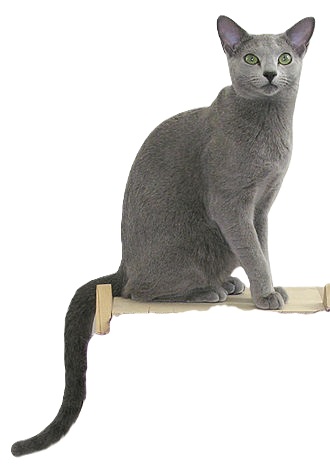
Russian blue
Description
The Russian Blue is an elegant and intelligent breed known for its striking blue-gray coat, bright green eyes, and reserved yet affectionate nature. They are often admired for their beauty, grace, and calm demeanor.
Appearance
- Russian Blues are medium-sized cats, with males typically weighing between 10-12 pounds (4.5-5.4 kg) and females slightly smaller at 7-10 pounds (3.2-4.5 kg). They have a slender, graceful build but are also muscular and strong.
- They have a lean, muscular body with long legs and a graceful appearance. Despite their slender look, Russian Blues are sturdy and well-proportioned. Their heads are wedge-shaped with a slight upturn at the corners of the mouth, giving them a natural "smiling" expression.
- The Russian Blue’s coat is one of its most distinguishing features. It is short, dense, and plush with a velvety texture. The coat is a uniform blue-gray color, with silver-tipped hairs giving it a shimmering, almost luminous quality.
- The coat is a solid blue-gray, with no other color variations allowed in breed standards. The shade of blue can range from a light silver to a darker slate, but the overall effect is always a cool, elegant blue.
- Russian Blues are known for their vivid green eyes, which stand out beautifully against their blue-gray fur. Kittens may be born with yellow eyes that turn green as they mature.
Personality
- Russian Blues are affectionate with their families but tend to be shy or cautious around strangers. They are known for forming strong bonds with their favorite humans and can be quite loyal and devoted. They enjoy attention but are not as demanding as some other breeds.
- Russian Blues are generally quiet cats, using soft, gentle vocalizations to communicate. They are not known for being overly vocal or noisy. Their calm and gentle demeanor makes them well-suited for quiet households.
- Russian Blues are intelligent and curious cats that enjoy interactive play. They are known for their problem-solving skills and love engaging with toys and puzzles that challenge their minds. Despite their reserved nature, they can be quite playful, especially with their trusted humans.
- Burmese cats are known for their dog-like loyalty to their owners. They are very devoted and enjoy cuddling, sitting on laps, and sleeping near or on their humans.
- While they enjoy spending time with their owners, Russian Blues are also content to be on their own for a while. They are independent cats and can keep themselves entertained, but they will seek out affection and companionship when they want it.
History
- The Russian Blue is an ancient breed, believed to have originated in the port city of Arkhangelsk in northern Russia. They are thought to have been brought to Europe by sailors in the 1860s, and they were first exhibited in England in the late 19th century. The breed gained popularity in Europe and North America over the years.
- During World War II, the Russian Blue population declined, but breeders in Europe and the United States worked to preserve the breed by crossing it with other blue-coated cats, such as the British Shorthair and Siamese. Over time, careful breeding re-established the distinct characteristics of the Russian Blue, and today it is a recognized and popular breed worldwide.
Unique traits
- While no cat is completely hypoallergenic, Russian Blues are often considered more suitable for allergy sufferers because they produce lower levels of the allergen Fel d 1 compared to other breeds. However, allergic reactions can still occur.
- The slight upturn at the corners of their mouth gives Russian Blues a natural "smiling" expression, adding to their gentle, serene appearance.
- The unique silver-tipped fur of the Russian Blue gives them a shimmering, almost luminous appearance, which is one of their most distinctive and admired traits.
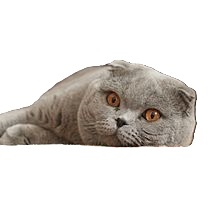
Scottish fold
Description
The Scottish Fold is a unique and charming breed known for its distinctive folded ears, which give it a sweet, owl-like appearance. These cats are affectionate, playful, and have a calm demeanor, making them wonderful companions for various households.
Appearance
- The most notable feature of the Scottish Fold is its folded ears, which are caused by a genetic mutation that affects the cartilage, causing the ears to fold forward and downward. This gives the breed its signature "owl" or "pixie" look. However, not all Scottish Folds have folded ears—those with straight ears are referred to as "Scottish Straights."
- Scottish Folds are medium-sized cats, with males typically weighing between 9-13 pounds (4-6 kg) and females between 6-9 pounds (2.7-4 kg).
- They have a rounded, stocky build with a compact, muscular body. Their heads are also rounded, with prominent cheekbones and large, expressive eyes that enhance their sweet expression.
- Scottish Folds can have either short or long coats, with the long-haired variety sometimes referred to as the "Highland Fold." The coat is dense and soft, with the short-haired version having a plush texture and the long-haired version being silky and slightly more flowing.
- Scottish Folds come in a wide variety of colors and patterns, including solid, tabby, bicolor, tortoiseshell, and more. Their coats can be any color except for pointed patterns (like Siamese).
- They have large, round eyes that add to their sweet and innocent appearance. Eye color varies depending on the coat color, but common colors include gold, copper, green, and blue.
Personality
- Scottish Folds are known for their affectionate nature and tend to form strong bonds with their families. They love being around people and often follow their owners from room to room. While they are affectionate, they are not overly demanding of attention.
- This breed has a calm and laid-back demeanor, making them ideal for families or individuals seeking a more relaxed cat. They are typically quiet and soft-spoken, preferring to communicate with gentle meows or chirps rather than loud vocalizations.
- While they enjoy playing, Scottish Folds are not known for being particularly high-energy or hyperactive. They like interactive toys and games but also spend a lot of time lounging and observing their surroundings.
- Scottish Folds are curious and intelligent cats. They enjoy exploring new environments and may learn simple tricks or games, such as fetch or puzzle toys. Their intelligence also makes them good at adapting to new situations or environments.
- Scottish Folds are adaptable and tend to get along well with other pets and children. Their easygoing nature makes them tolerant of changes in their environment or routine.
History
- The Scottish Fold breed originated in Scotland in 1961 when a white barn cat named Susie was discovered with unusual folded ears. Susie was bred with other cats, including British Shorthairs and domestic cats, to develop the Scottish Fold breed. The gene responsible for the ear fold was identified as a dominant gene, meaning only one parent needed to carry the trait for the offspring to have folded ears.
- The Scottish Fold was initially bred in Scotland and the United Kingdom, but due to concerns about potential health issues related to the ear fold gene, breeding was restricted in some places. However, the breed gained popularity in the United States, where breeders worked to ensure the health and standard of the breed. Today, the Scottish Fold is recognized by major cat associations like The International Cat Association (TICA) and the Cat Fanciers' Association (CFA).
Unique traits
- The defining characteristic of the breed, folded ears are caused by a genetic mutation that affects cartilage. However, not all Scottish Folds are born with folded ears—some have straight ears but are still considered part of the breed.
- Many Scottish Folds are known for their habit of sitting in unusual positions, such as sitting up like a human with their back against a surface and their legs stretched out. This posture is endearing and adds to their quirky, laid-back personality.
- Scottish Folds are generally quiet cats, with soft, sweet voices. They are not known for being overly vocal, though they will communicate with their owners through gentle meows and purring.
Japanese bobtail
Description
The Japanese Bobtail is a unique and ancient breed known for its distinctive short, “pom-pom” tail and lively, outgoing personality. This breed has been cherished in Japan for centuries, often appearing in folklore, art, and as the inspiration for the famous “Maneki-neko” or “beckoning cat” figurine.
Appearance
- Japanese Bobtails are medium-sized cats, with males typically weighing between 7-10 pounds (3.2-4.5 kg) and females slightly smaller at 5-7 pounds (2.3-3.2 kg). They have a slim, elegant, and athletic build.
- They are well-muscled with a long, lean body, long legs, and a triangular-shaped head. Their overall appearance is graceful yet sturdy, with a lithe and agile frame that reflects their energetic nature.
- The most distinctive feature of the Japanese Bobtail is its short, bobbed tail. Unlike most cats, their tail is not long and sleek but rather a unique “pom-pom” that is often kinked, curled, or bent. The tail is usually about 2-4 inches long and is as individual to each cat as a fingerprint. It is covered in fur, which gives it a fluffy appearance.
- Japanese Bobtails can have either short or long coats, both of which are soft and silky to the touch. Their coats tend to lie flat against the body and are relatively easy to groom.
- They come in a wide variety of colors and patterns, but the most iconic and beloved color pattern is the Mi-ke (pronounced "mee-keh"), meaning “three fur” or calico, which features a combination of white, black, and red. Other common colors include solid, tabby, and bicolor patterns.
- Japanese Bobtails have large, almond-shaped eyes that give them an alert and intelligent expression. Their eye color can be gold, green, blue, or odd-eyed (two different colored eyes), which is especially striking.
Personality
- Japanese Bobtails are highly energetic, playful, and curious. They love interactive games and are known for their strong jumping abilities, often seen leaping to high perches or exploring their surroundings.
- These cats are very social and enjoy being around people. They form strong bonds with their families and often follow their owners from room to room. They are affectionate without being overly clingy, making them great companions.
- Japanese Bobtails are highly intelligent and quick learners. They enjoy puzzle toys, learning tricks, and even playing games like fetch. Their inquisitive nature means they love exploring their environment and figuring out how things work.
- One of the breed's most charming traits is their melodious, chirping voice. Japanese Bobtails are known for being vocal, though their meows are soft and pleasant. They use a wide range of sounds to communicate with their humans, and they seem to "talk" more than many other breeds.
- Japanese Bobtails are highly adaptable to different environments, making them a good fit for both busy households and quieter settings. They adjust well to changes, new people, and even traveling.
History
- The Japanese Bobtail is an ancient breed that has been part of Japanese culture for centuries, with records dating back over 1,000 years. They are native to Japan and are often associated with good fortune and prosperity.
- Japanese Bobtails have been depicted in Japanese art, literature, and folklore for centuries. They are considered symbols of good luck and prosperity in Japan, and the famous "Maneki-neko" (beckoning cat) figurine, which is believed to bring good fortune, is modeled after the Japanese Bobtail.
- The breed was introduced to the United States in the late 1960s and quickly gained recognition due to its unique appearance and friendly nature. Today, they are recognized by major cat registries, including The International Cat Association (TICA) and the Cat Fanciers' Association (CFA).
Unique traits
- The unique, bobbed tail of the Japanese Bobtail is unlike any other cat breed. It is the result of a genetic mutation and is a defining feature of the breed. The tail can vary in length and shape, but it is always short and often curled or kinked.
- The Japanese Bobtail is deeply embedded in Japanese culture and is a living symbol of good fortune. The "Maneki-neko," or "beckoning cat," is thought to be modeled after the Bobtail, with its raised paw inviting good luck and prosperity.
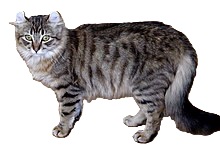
American curl
Description
The American Curl is a unique and playful breed known for its distinctive ears, which curl backward, giving it an unmistakable and charming appearance. This breed combines a curious, friendly personality with an adaptable and social nature, making it a delightful companion.
Appearance
- American Curls are medium-sized cats, with males typically weighing between 7-12 pounds (3-5.5 kg) and females weighing slightly less, around 5-8 pounds (2.3-3.6 kg).
- They have a slender, elegant build with a well-muscled body. Their overall frame is balanced, neither too bulky nor too lean, and they possess a graceful appearance.
- The most distinctive feature of the American Curl is, of course, its ears. They curl backward in a unique arc, typically forming a 90 to 180-degree curve. The degree of curl varies, and the ears start straight at birth, beginning to curl within a few days. The cartilage in the ears is firm, giving them their distinctive shape. The backward curl is a result of a natural genetic mutation.
- Curls come in both long-haired and short-haired varieties. Their coat is soft, silky, and lies close to the body, with minimal undercoat, meaning they are relatively low-shedding and easy to groom.
- The breed comes in a wide variety of colors and patterns, including solid, tabby, tortoiseshell, bicolor, and more.
- The American Curl’s tail is typically long and proportionate to the body, covered in dense fur, especially in long-haired individuals.
- They have large, walnut-shaped eyes that can come in a wide range of colors, depending on the coat color. Their eyes give them an alert and curious expression.
Personality
- American Curls are known for their friendly, affectionate nature. They enjoy spending time with their families and are known to follow their humans around the house. They are social cats that enjoy interacting with people and other pets.
- Curls retain a kitten-like curiosity and playfulness well into adulthood. They love interactive games, toys, and activities that challenge their minds. Their curiosity often leads them to explore new spaces and objects in the house.
- While they enjoy being with their people and are affectionate, they are not overly demanding or clingy. They are happy to snuggle with their owners but also have an independent side, making them adaptable to different types of households.
- American Curls are generally quiet cats, using soft chirps or trills to communicate rather than loud meows. They are not typically vocal, which can be a plus for those who prefer a quieter pet.
- Their easygoing and adaptable nature makes them great companions for families with children or other pets. They are tolerant, patient, and generally get along well with everyone.
History
- The American Curl breed is relatively new, originating in the United States in the early 1980s. The first known Curl was a stray long-haired black female cat named Shulamith, who was found in Lakewood, California, in 1981. She had the distinctive curled ears that later became the hallmark of the breed. Shulamith's kittens inherited the curled ears, and breeders recognized that this was a genetic trait. This led to the development of the breed.
- The breed gained rapid popularity, and in 1987, the American Curl was recognized by The International Cat Association (TICA). In 1993, the breed was accepted for Championship status by the Cat Fanciers' Association (CFA), making it a relatively new but established breed.
Unique traits
- The backward-curled ears are the breed’s most iconic feature. The degree of curl varies among individuals, but the ears should not be rigid; they should have a natural, flexible feel. The curled ears are the result of a spontaneous genetic mutation, and both short-haired and long-haired Curls can have this trait.
- American Curls are known for maintaining their kitten-like curiosity and playfulness well into adulthood, making them a lively and entertaining companion.
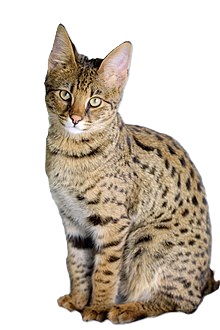
Savannah
Description
The Savannah cat is a striking and exotic breed, known for its wild appearance, large size, and adventurous personality. It’s a hybrid breed, resulting from the cross between a domestic cat and a serval, a medium-sized African wildcat. Savannah cats are known for their energy, intelligence, and loyalty, often described as having "dog-like" traits.
Appearance
- Savannah cats are among the largest domestic cats, with their size largely depending on their generation (how many generations they are from their serval ancestor). Early generation (F1-F3) Savannahs are typically larger, with males weighing between 15-25 pounds (6.8-11.3 kg) and females slightly smaller at 12-20 pounds (5.4-9.1 kg). Later generations (F4 and beyond) are smaller but still larger than most domestic cats.
- Savannahs are tall, long, and slender cats with long legs, large ears, and a lean, muscular body. Their long legs and athletic build give them a graceful, wildcat-like appearance. They often appear larger than their actual weight due to their height and body length.
- The Savannah's coat is one of its most distinctive features, marked by bold spots and stripes reminiscent of its serval ancestry. The coat is short to medium in length and has a sleek, smooth texture.
- The classic pattern is spotted, with large, dark spots across the body that contrast with the base coat color.
- Common coat colors include brown, silver, black, and smoke, with spots that are usually black or dark brown.
- The Savannah’s tail is relatively short compared to its body and is typically thick, with bold black rings and a black tip.
- Savannah cats have large, tall ears that sit high on their heads, a trait inherited from the serval. The ears are often marked with distinctive “ocelli” (eye-like markings) on the backs, which may help ward off predators in the wild.
- They have almond-shaped eyes, and the eye color can vary depending on the coat color. Common colors include green, gold, copper, and sometimes blue in kittens or lighter-coated individuals.
Personality
- Savannah cats are highly active and energetic. They love to run, jump, and play, and need plenty of space and stimulation. Due to their high energy levels, they benefit from large living spaces or environments where they can climb, explore, and be mentally stimulated.
- Savannahs are exceptionally intelligent cats and are quick learners. They can be trained to walk on a leash, play fetch, and even perform tricks. Their curiosity often leads them to explore every nook and cranny of the house, and they are known for figuring out how to open doors, cabinets, or faucets.
- While Savannahs are independent and adventurous, they are also known for forming strong bonds with their human families. They are often described as "dog-like" because they tend to follow their owners around the house and enjoy interactive play. Early generation Savannahs, especially F1 and F2, tend to form a close bond with one or two people, while later generations are more social with multiple family members.
- Savannahs are known for being loyal and protective of their families. They may act aloof with strangers at first but are usually friendly once they become familiar. Their protective nature is another trait they share with dogs, as they may try to "guard" their home or owners.
History
- The Savannah cat was first bred in the 1980s by crossing a domestic cat with a serval, a wild African cat known for its tall ears, long legs, and spotted coat. The first known Savannah cat, named "Savannah," was born in 1986. The breed was developed to create a domestic cat with the striking appearance of a wildcat but the temperament of a pet.
- Savannah cats quickly gained popularity due to their exotic appearance and unique personality. The breed was officially recognized by The International Cat Association (TICA) in 2001. However, Savannahs are still considered a relatively rare breed.
Unique traits
- Savannah cats are known for their exceptional jumping ability. They can leap 8 feet or higher from a standing position, so they may enjoy perching on high places in the home.
- Many Savannahs enjoy water and may play in sinks, bathtubs, or even join their owners in the shower. This trait is inherited from their serval ancestors, which are known to hunt fish and small animals near water.
Ocicat
Description
The Ocicat is a striking, domestic cat breed known for its wild appearance, resembling a small wild cat, but with the temperament of a loving and social pet. They are named for their resemblance to the ocelot, a wild cat species, though they have no wild blood in their lineage.
Appearance
- Ocicats are medium to large cats with a well-muscled and athletic build. Males typically weigh between 9-15 pounds (4-6.8 kg), while females are slightly smaller, weighing around 6-9 pounds (2.7-4 kg).
- They have a sleek, muscular body with a deep chest and strong legs. Their athletic physique gives them an agile, graceful, and powerful appearance. Despite their wild look, Ocicats move with elegance and confidence.
- Ocicats have a short, smooth coat with a satin-like texture that is close-lying to the body. The coat’s most distinctive feature is its pattern of randomly placed spots, which gives them their exotic, wild appearance.
- The spots are arranged in a bullseye pattern, with larger spots on the body and smaller spots on the legs and face. Each individual hair has bands of color (called "agouti" hairs), contributing to the breed's distinctive ticking.
- Common coat colors include brown, silver, black, and smoke, with spots that are usually black or dark brown.
- Ocicats come in a variety of colors, including tawny (brown), chocolate, cinnamon, blue, lavender, fawn, and silver variations of these shades. The background color contrasts with the spots, creating a striking visual effect.
- They have medium to large ears, sometimes with small tufts, giving them an exotic, alert look.
- Ocicats have large, almond-shaped eyes that can come in a range of colors, including gold, green, and copper. Blue eyes are not accepted in the breed standard unless the Ocicat is a pointed variety (not common).
Personality
- Despite their wild appearance, Ocicats are known for their friendly, affectionate nature. They are social cats that love human interaction and enjoy being part of the family. They tend to form strong bonds with their owners and thrive on companionship.
- Ocicats are very active, playful cats. They love games, interactive toys, and playtime with their owners. Their energy and intelligence make them natural athletes, and they enjoy climbing, jumping, and exploring their surroundings.
- Ocicats are highly intelligent and can be easily trained to perform tricks, walk on a leash, or play fetch. They enjoy mental stimulation and can be taught commands similar to dogs. Their intelligence, combined with their eagerness to please, makes them quick learners.
- Ocicats are naturally curious cats and love to investigate new things in their environment. They have a sense of adventure and are not typically shy or timid, making them bold explorers.
- Ocicats often follow their owners from room to room, wanting to be involved in whatever is happening. They love being at the center of attention and are good at communicating their needs with soft chirps or meows.
History
- The Ocicat breed was developed in the United States in 1964 by breeder Virginia Daly. The breed’s creation was an accident when Daly was attempting to breed an Abyssinian-Siamese mix with the goal of creating a Siamese with Abyssinian points. However, one kitten in the litter had spots, resembling a wild cat, which piqued interest. This spotted cat was named Tonga and became the foundation for the Ocicat breed.
- The breed was further developed by crossing Siamese, Abyssinian, and American Shorthair cats, resulting in the distinctive spotted coat pattern of the Ocicat. The breed gained popularity due to its wild look combined with its domesticated, friendly personality. Ocicats were officially recognized by The International Cat Association (TICA) in 1987 and by the Cat Fanciers’ Association (CFA) in 1986.
Unique traits
- The most unique aspect of the Ocicat is its wild appearance combined with its domestic, loving personality. Despite looking like a wild cat, they are fully domesticated and make excellent family pets.
- Ocicats are known for their dog-like behavior, such as being easily trainable, playing fetch, and walking on a leash. They are loyal and often follow their owners around the house.
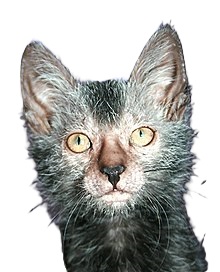
Lykoi
Description
The Lykoi, often referred to as the "werewolf cat," is a relatively new and unusual breed known for its unique, scruffy appearance and playful, curious nature. The breed's name comes from the Greek word "lykos," meaning "wolf," which reflects their wolf-like appearance. Despite their wild looks, Lykoi are affectionate and social cats with a loving personality.
Appearance
- Lykoi cats are medium-sized, with a lean, athletic build. They typically weigh between 6-12 pounds (2.7-5.4 kg), with males generally being larger than females.
- Lykoi have a slender, muscular body with long legs, which gives them a lithe, agile appearance. Their paws are slightly elongated, adding to their distinct look.
- One of the most distinctive features of the Lykoi is its partial coat, which gives it a scruffy, patchy appearance. Lykoi cats are partially hairless, with some areas of their body having sparse fur, particularly around the face, legs, and body.
- The fur that they do have is coarse and wiry, unlike the soft fur of most other breeds. This gives them a wild, unkempt look.
- Lykoi are typically black or black roan, a unique coloration where the black fur is mixed with white hairs, giving them a silver or grayish hue. Their coloration, along with their sparse coat, contributes to their wolf-like appearance.
- Lykoi are known to shed their coat periodically, and during shedding cycles, they can look even more hairless. After shedding, the coat will regrow, but it may still retain its patchy appearance.
- The Lykoi’s face is triangular, with large, wide-set eyes that give them an alert, intense expression. Their ears are large and pointed, further enhancing their wolf-like look.
- Lykoi have striking, almond-shaped eyes that are usually gold or green, contributing to their intense, "wild" appearance.
Personality
- Despite their wild looks, Lykoi are loving and affectionate cats. They form strong bonds with their owners and enjoy spending time with their family members, often following them around the house.
- Lykoi are highly active and playful. They enjoy interactive games, exploring, and climbing. Their inquisitive nature means they will often investigate every corner of their environment.
- Lykoi are very intelligent cats that love to explore and solve problems. Their curiosity can lead them to get into cabinets, drawers, or other tight spaces, making them excellent escape artists.
- While they enjoy human companionship, Lykoi also have an independent streak. They are content to entertain themselves and explore on their own, but they also appreciate attention and affection from their owners.
- Lykoi are sometimes compared to dogs in their behavior, as they are highly loyal and enjoy following their owners around. They may even play fetch or engage in other dog-like activities.
History
- The Lykoi breed is a relatively new discovery, with the first Lykoi cats being identified in 2010 in the United States. The breed developed from natural mutations found in domestic shorthair cats. The mutation that caused the distinctive partial hairlessness and "werewolf" appearance was not the result of selective breeding but occurred naturally.
- The first Lykoi cats were discovered in feral cat populations in Tennessee, and breeders began working with these naturally occurring cats to create a stable breed. In 2011, the breed gained recognition from The International Cat Association (TICA).
- The name "Lykoi" was chosen because of the breed’s wolf-like appearance, derived from the Greek word for wolf, "lykos."
Unique traits
- The Lykoi’s most unique trait is its werewolf-like appearance, which is due to the partial hairlessness caused by a genetic mutation. This mutation results in the cat’s distinctive scruffy, patchy coat that is often compared to a wolf or wild animal.
- Lykoi cats can shed their fur and then regrow it, often leading to changes in their coat’s appearance. This unique shedding pattern adds to their ever-changing and wild look.
- Unlike some other cat breeds that were developed through selective breeding, the Lykoi is a natural mutation from domestic shorthairs, making them a unique and rare breed.
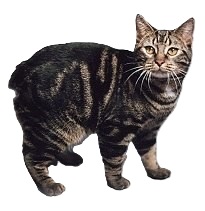
Manx
Description
The Manx is a unique and ancient breed known primarily for its lack of a tail, a distinctive feature that sets it apart from other cats. Originating from the Isle of Man, this breed is cherished for its friendly, playful personality and strong build.
Appearance
- Manx cats are medium to large in size, with males typically weighing between 10-12 pounds (4.5-5.5 kg) and females slightly smaller at 8-10 pounds (3.5-4.5 kg). They have a compact, muscular body that gives them a powerful and sturdy appearance.
- Manx cats are known for their stocky build, broad chest, and short back. Their strong hind legs are slightly longer than their front legs, giving them a distinctive, rabbit-like hopping gait when they run.
- The most defining trait of the Manx is its tail, or lack thereof. Manx cats come in several tail types:
- Rumpy: Completely tailless, with only a slight hollow where the tail would be.
- Rumpy Riser: A very small bump or rise at the base of the spine.
- Stumpy: A short, stubby tail that is typically one to three vertebrae long.
- Longy: A longer tail, though it’s still shorter than the average cat's tail. Breeding Manx cats can produce any of these tail variations, though the tailless or nearly tailless (rumpy and rumpy riser) are the most famous.
- The Manx has a double-layered coat that can be either short or long, depending on the specific variety. Shorthaired Manx have a dense, soft coat, while longhaired Manx (often referred to as Cymrics) have a longer, plush coat.
- Manx cats come in a wide range of colors and patterns, including solids, tabbies, tortoiseshells, and bicolors.
Personality
- Manx cats are known for their strong bonds with their human families. They are affectionate and enjoy being around people, often following their owners from room to room. Their devotion to their families has earned them a reputation for being "dog-like" in their loyalty.
- Despite their stocky build, Manx cats are very playful and energetic. They enjoy interactive games and are known for their excellent jumping ability, thanks to their powerful hind legs. Many Manx cats enjoy fetching toys, much like dogs.
- Manx cats are highly intelligent and can be trained to perform tricks, open doors, or solve puzzle toys. Their curiosity means they enjoy exploring their environment and finding new hiding places or perches.
- While active and playful, Manx cats are also known for their calm and adaptable nature. They tend to handle changes in their environment well and are generally laid-back cats.
History
- The Manx breed originates from the Isle of Man, a small island in the Irish Sea between Great Britain and Ireland. Their lack of a tail is the result of a natural genetic mutation that occurred among the island’s cat population centuries ago. Over time, this trait became more common through inbreeding due to the island's isolation.
- The Manx breed has been recognized for its unique appearance and personality for many years. They were one of the first breeds recognized by cat fanciers in the 19th century, and they have remained a popular show cat ever since. Today, they are recognized by all major cat registries, including The International Cat Association (TICA) and the Cat Fanciers' Association (CFA).
Unique traits
- The most well-known trait of the Manx is its lack of a tail, which is caused by a genetic mutation. This trait is a hallmark of the breed and distinguishes it from most other cats.
- Due to their strong hind legs, Manx cats often move with a distinctive hopping gait, much like a rabbit, which adds to their charm.
- Historically, Manx cats were known as excellent swimmers, likely due to their origins on the Isle of Man, where they had to survive on an island environment.
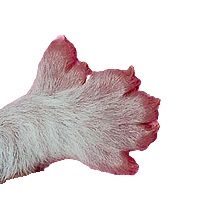
Polydactyl
Description
Polydactyl cats are cats born with more toes than the typical number. Most cats have five toes on their front paws and four on their back paws, but polydactyl cats can have six, seven, or more toes on one or more paws. This condition, known as polydactylism or polydactyly, is a genetic mutation that results in extra digits.
Appearance
- Polydactyl cats can have anywhere from one to several extra toes on their paws. The most common place for the extra digits is the front paws, but some cats can have extra toes on their hind paws or even all four paws.
- A typical polydactyl cat might have six or more toes on the front paws and five or more on the back.
- Polydactyl cats often have larger or wider paws, giving them a distinctive look. The extra toes may look like "thumbs" or additional, smaller digits. Some cats with pronounced extra digits are sometimes referred to as "mitten cats" because their paws resemble mittens.
Personality
- Some owners of polydactyl cats report that their cats seem to have increased dexterity, using their extra toes to grasp objects or open latches more effectively. However, this varies from cat to cat.
History
- Polydactyl cats are often called "Hemingway cats" because of their association with the famous author Ernest Hemingway. Hemingway was given a six-toed cat named Snowball by a ship captain, and many of the cats living at the Hemingway Home and Museum in Key West, Florida, today are descendants of Snowball. The museum is home to many polydactyl cats, and they have become synonymous with Hemingway.
- Polydactyl cats were historically popular among sailors, especially in the 18th and 19th centuries. Sailors believed these cats brought good luck, and their extra toes were thought to give them better balance and climbing abilities, making them ideal ship companions for catching mice.
- Polydactylism is more common in certain parts of the world. For example, polydactyl cats are more frequently found in areas along the East Coast of the U.S., particularly in New England and parts of Canada, where many of these ship cats ended up.
Polydactyl Cats in Different Breeds
- Polydactylism can occur in any cat breed, but it is particularly common in Maine Coon cats, where the trait was more frequent in the early history of the breed. It’s estimated that about 40% of Maine Coons in the past had extra toes, although modern breeding standards have reduced this number.
- While polydactylism is not associated with specific health problems, some breed standards do not allow for polydactyl cats to be shown in certain cat competitions.
Polydactylism vs. Other Genetic Conditions
- Polydactylism is sometimes confused with a more severe condition called radial hypoplasia, in which the radius (a bone in the leg) is underdeveloped, leading to twisted or misshapen limbs. However, these two conditions are different; radial hypoplasia can affect a cat’s mobility, while polydactylism typically does not.
Fun facts
- The Guinness World Record for the most toes on a cat is held by a Canadian cat named Jake, who has 28 toes—seven on each paw.
- In some cultures, polydactyl cats are considered lucky, especially among sailors. They were believed to have better balance on rough seas and were seen as symbols of protection.
